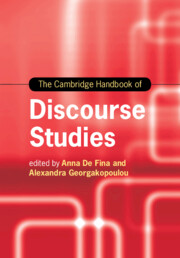Book contents
- The Cambridge Handbook of Discourse Studies
- Cambridge Handbooks in Language and Linguistics
- The Cambridge Handbook of Discourse Studies
- Copyright page
- Contents
- Figures
- Tables
- Contributors
- Preface
- Part I (Con)Textualizing Discourses
- Part II Perspectives and Modes of Analysis
- Part III Discourse Materialities and Embodiment
- Part IV (Trans)Locations and Intersections
- Part V Ethics, Inequality and Inclusion
- 21 Ethics and the Study of Discourse
- 22 Migrants, Citizenship and Language Rights
- 23 Diversity and Inclusion in Education
- 24 Discourse and Racialization
- 25 Discourse and Narrative in Legal Settings: The Political Asylum Process
- 26 Discourse and Religion in Educational Practice
- Part VI Discourses, Publics and Mediatization
- Index
- References
23 - Diversity and Inclusion in Education
from Part V - Ethics, Inequality and Inclusion
Published online by Cambridge University Press: 28 September 2020
- The Cambridge Handbook of Discourse Studies
- Cambridge Handbooks in Language and Linguistics
- The Cambridge Handbook of Discourse Studies
- Copyright page
- Contents
- Figures
- Tables
- Contributors
- Preface
- Part I (Con)Textualizing Discourses
- Part II Perspectives and Modes of Analysis
- Part III Discourse Materialities and Embodiment
- Part IV (Trans)Locations and Intersections
- Part V Ethics, Inequality and Inclusion
- 21 Ethics and the Study of Discourse
- 22 Migrants, Citizenship and Language Rights
- 23 Diversity and Inclusion in Education
- 24 Discourse and Racialization
- 25 Discourse and Narrative in Legal Settings: The Political Asylum Process
- 26 Discourse and Religion in Educational Practice
- Part VI Discourses, Publics and Mediatization
- Index
- References
Summary
In many parts of the world, the enduring inequalities in both educational experiences and academic outcomes across linguistically and culturally different groups complicate widespread discourses of “diversity” and “inclusion.” The study of discourse, as a means of theoretical and methodological inquiry, has advanced our collective understanding of how social power and inequality are enacted, (re)produced and resisted through texts and discourse-in-interaction in educational contexts. This chapter begins with an overview of early work that has yielded remarkable insights into how diversity and inclusion are patterned in and through everyday classroom socialization routines. It then proceeds to sketch how current trends of discourse study have enriched our discussion of the complexity of language, ideology and power inherent in the educational discourse. We present ongoing tensions concerning the theoretical, methodological and applied dimensions of this work. The chapter concludes by delineating some implications for educational practices and future directions for expanded work in the study and understanding of discourses of diversity and inclusion.
Keywords
- Type
- Chapter
- Information
- The Cambridge Handbook of Discourse Studies , pp. 505 - 526Publisher: Cambridge University PressPrint publication year: 2020
References
Further Reading
To further learn about how different discourse approaches applied to critically examine diversity and inclusion in educational contexts, how locally situated practices and identity shape and are shaped by broader institutional or sociopolitical ideologies, and the relationships between researcher and the researched, we recommend the following three books:
Bucholtz examines how white teenage students use their linguistic resources (e.g., Valley Girl speech, African American English) to demonstrate identities based on race and youth cultures, and to position themselves and others in accordance with the school’s racialized social order.
This edited book discusses multilingualism and discourse from different sociolinguistic and/or ethnographic perspectives, reviews conceptual and methodological concerns and challenges that researchers face, and suggests future directions in the relevant fields.
This edited book provides an introduction to critical discourse analysis, reviewing various theories and methods associated within the fields of applied linguistics and linguistic anthropology. It also examines how critical discourse analysis, as a theory and method, is applied to the research of diversity, exclusion and inclusion in educational and societal contexts.



